

Contact us anytime to know more — Kuldeep K., Founder & CEO CISIN
Salesforce Shield was developed specifically for enterprises requiring additional security and compliance measures.
Salesforce Shield includes Four components - encryption, Increased field audit trail, Event monitoring, Einstein Data Detect - of which encryption stands out as its cornerstone feature.
Salesforce Shield unifies Compliance & Security Team (CISO) members and Salesforce Administrators into one cohesive group regarding essential compliance procedures.
Switching to Salesforce Shield does not ensure success; instead, it should be considered one of many security controls in an environment like Salesforce's. This tutorial will describe the components and strategy incorporated in Salesforce Shield and provide advice for maximizing its benefits - also known as OwnBackup's "Shield Path to Value”.
What Is Salesforce Shield?

Salesforce Shield was developed for enterprises requiring additional layers of security model and compliance features, comprising of parts as described here:
- Platform Encryption: Protect data when stored natively within Salesforce data centers using platform encryption to encrypt stored "at rest," for instance, field modifications via an audit trail and archive field history data up to 10 years ago.
- Event Monitoring: Monitoring user activities to reduce and avoid potential hazards and reduce harm, while Einstein Data Detect identifies sensitive information for deeper insights.
Shield's capabilities as a Salesforce Platform solution extend across all cloud products used within an organization and help reduce data threats on various fronts.
Salesforce Shield is an add-on product whose cost must be added onto standard Salesforce CRM licensing types. Regarding purchasing arrangements, there are four components - the entire umbrella (all four components at once or individually if preferred) and purchasing individual pieces based on regulatory or business needs.
Why You Need Salesforce Shield

Salesforce provides superior infrastructure - hardware, network services, and the underlying architecture - but adheres to a shared security responsibility model, meaning both it (the vendor) and your organization (the customer) share security responsibilities; you must, therefore, approve any Salesforce configuration/customization before being deployed, and ultimately, liability for risks related to them will rest with you as the customer trust.
12 Salesforce Security Best Practices For 2024

Salesforce boasts a 19.8% market share for CRM systems, surpassing its four main rivals combined. Such widespread support demonstrates both their dependability and broad reach - while simultaneously emphasizing security as an imperative feature.
Organizations face an average SaaS data breach risk of more than $28 million annually; Salesforce is no exception here as an app-as-a-service (SAAS).
Most cloud and SaaS platforms operate using a shared responsibility model where each party shares responsibility for different aspects of account and data security risk; for example, in Salesforce, this could mean you are handling some aspects while your vendor handles others. This tutorial will walk you through 12 fundamental salesforce data security best practices for measures crucial in protecting your account and sensitive data from phishing attack vectors.
Run Health Check
Integrated into Salesforce's basic architecture, Salesforce Health Check offers administrators a complete and complementary tool for assessing and improving their organization's security configurations.
Health Check is an invaluable application that quickly identifies and suggests recovery solutions for security vulnerabilities while empowering administrators to develop and enforce specific baseline standards tailored to business requirements.
Organizations can utilize Health Check to test whether their Salesforce instance can withstand potential security threats while adhering to recommended practices.
Enable MFA
Multi-factor authentication (MFA) is an essential defense mechanism, offering extra layers of security policies against threats such as phishing attempts, credential stuffing, and illegal account access.
Organizations using MFA significantly bolster their protective barriers that secure Salesforce data - one of many best practices recommended to strengthen digital assets against security breaches. This extra step ensures integrity for every Salesforce data set an enterprise owns.
Evaluate User Privileges
Permission sets provide you with a way to limit who can do what in your Salesforce system. Begin by understanding your users' jobs and tasks and establish permission sets accordingly.
Remove any rights that might pose threats; however, if a user needs them again, you can return them through permission sets - thus enabling everyone to complete their jobs safely while remaining productive.
Use The Principle Of Least Privilege
Under the least privilege, users should only possess access to what is necessary for them to execute their jobs effectively.
Instead of giving everyone complete control of everything, restricting access is safer; for instance, if someone needs only access to read but not modify data, then only they should possess this level of access - this reduces risks as any damage done should an account fall into the wrong hands is limited - providing another simple yet effective strategy for protecting Salesforce setup.
Allow Access Only To Trusted Login IPs
Limiting access using IP addresses can help protect salesforce data security backups by keeping unwanted people away.
Administrators can designate "safe" IP ranges that only permit logins from these IPs; any attempt from untrusted addresses will either be banned from login or asked to verify they are who they say they are - protecting from unauthorized access and potential phishing attempts.
Ensure Connection Security
Protecting Salesforce data requires an encrypted internet connection that's both fast and safe, such as VPN access on an ongoing basis.
Also, be sure to set your router correctly - enable WPA2 or WPA3 encryption, and update its firmware regularly - this way, unauthorized devices don't gain entry, and all data is kept away from prying eyes.
Use An Authenticator
Utilizing Salesforce Authenticator as one of their security recommendations is another must for Salesforce security.
It is an efficient two-factor authentication solution, adding another level of protection when accepting logins or actions via mobile device tap-based login. In addition, its Smart Location Tracking can recognize secure areas when users enter them automatically -- plus users have the choice of using third-party solutions services such as Google or Microsoft Authenticators as extra layers of protection against theft or malware attacks.
All in all, security should be simple yet effective for everyone.
Use A Saas Security Tool
Implementing security measures becomes even more crucial as companies rely on SaaS solutions such as Salesforce for daily activities, making incorporating SaaS security tools essential.
A SaaS security tool provides businesses with active vulnerability monitoring, user access monitoring, and privilege administration across all SaaS apps used in your organization - such as Salesforce - quickly flagging any abnormal activity within its environment.
Train Users About Security Awareness
Your team's education is vital in protecting Salesforce data. Even the most robust security systems may be bypassed if consumers remain unaware of potential threats; regular training sessions will assist your staff in recognizing hazards such as suspicious emails or unusual login prompts, giving everyone access to up-to-date knowledge regarding security procedures and potential risks; more informed teams make for safer teams overall.
Apply Password Security Best Practices
Passwords serve as the initial defense against unwanted access, making solid and hard-to-guess passwords crucial for keeping confidential data protected and accessible.
Encourage users to create unique Salesforce passwords rather than easily identifiable ones such as "password123" or their birth dates, increasing security for everyone involved.
Passwords can be made more secure by periodically switching them, using combinations of letters, numbers, and symbols, and minimizing platform recurrences.
Furthermore, please refrain from discussing passwords publicly or writing them somewhere others could see them; these basic principles will significantly lower the risk of illegal access.
Strengthen Data Security With Shield Platform Encryption
Salesforce Shield is a set of advanced security measures explicitly created for Salesforce. It ensures organizations trust, comply with, and confidently govern their critical apps.
Shield Platform Encryption stands out in this package by offering unparalleled data security. Shield Platform Encryption ensures your sensitive data remains encrypted when stored or at rest, unlike regular encryption, which only protects transmission.
This enables organizations to meet privacy policies, regulatory authorities, and contract agreements for securely handling sensitive information.
Salesforce Shield features event monitoring, field audit trail capabilities, and platform encryption, forming a solid security architecture.
If you are considering Salesforce Shield for use within your organization, make sure you first speak to an administrator to see if it's available before proceeding further.
Beware Of Phishing Emails
Phishing is an innovative tactic used by criminals to trick consumers into providing personal data they should not give out.
Emails masquerading as legitimate may contain hidden agendas; users could unwittingly download dangerous malware that harvests personal data when clicking links or downloading files in these emails. Always be wary of unexpected or suspicious emails; always double-check them, and avoid anything that looks amiss before seeking advice from IT staff or security specialists.
What Are Salesforce Security Features?

Salesforce security features are designed to safeguard user data and enhance their experience.
Here's a brief rundown:
Security Health Check
- Health Check, explicitly designed for administrators, allows them to quickly identify and correct potential weaknesses in security settings from one central dashboard.
- Summary scores compare your firm's security level against predefined baselines such as Salesforce Baseline Standard or can even include custom fields baselines for more granular analysis.
Phishing And Malware
- Salesforce values transparency and trust; should anything appear amiss with your Salesforce configuration, please report it immediately to security@salesforce.com and your internal IT team.
- Salesforce delivers real-time statistics to businesses regarding system performance, security alerts, phishing attempts, malware attempts, and best practices and guidelines.
Manage Redirects To External URLs
- Salesforce promotes honesty and openness; should anything appear irregular with your Salesforce configuration, notify security@salesforce.com as soon as possible, along with internal IT staff members.
- Salesforce provides real-time monitoring data regarding system performance, security alerts, and any phishing or malware attempts at trust.salesforce.com.
This website also features security best practices and guidelines explicitly tailored towards businesses.
Security Infrastructure
- Salesforce uses cutting-edge internet security software.
Your information is safeguarded using Transport Layer Security (TLS), guaranteeing only authorized individuals can access it within your business.
Auditing
- Audits provide valuable insights into system usage, which is invaluable for detecting and mitigating security vulnerabilities.
While Salesforce offers this functionality for auditing purposes, for optimal use, it should be combined with regular internal audits that monitor for potential misuse and ensure users' compliance.
Conclusion
Enhancing salesforce security for business solutions is highly adaptable and flexible, giving administrators complete freedom to tailor them specifically to the regulatory requirements of their organization.
Your responsibility as administrator would include enforcing adequate data access across your firm while ensuring roles perform their functions successfully. Implementation may take some time; make time each month to audit and adjust security measures to safeguard what your company considers their most vital resource - information.
Data classification can help direct Shield's efforts more efficiently and ensure all sensitive information within an organization remains protected.
From selecting which fields should be encrypted or tracked for event monitoring to knowing where events should occur - data classification helps make Shield work efficiently while safeguarding all your most confidential assets.

